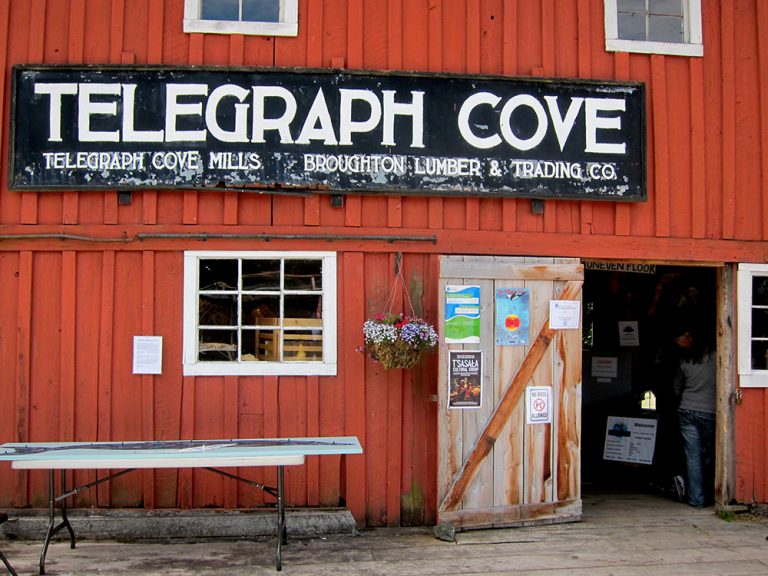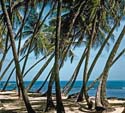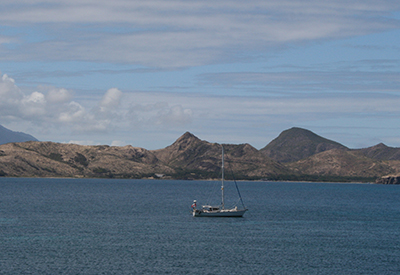Cruising BC’s Wild—and Working—Coast on a Landing Craft
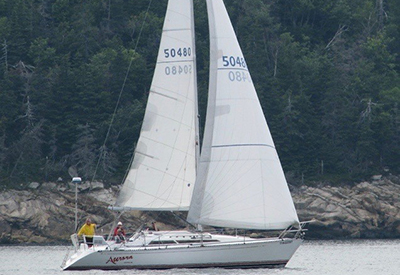
By Marianne Scott
Aurora allows some leg stretching on a beach
In early August, in Menzies Bay just north of Campbell River, my husband David and I joined 10 other passengers walking up the ramp and through the Aurora Explorer’s cargo area. Our experience with landing crafts had been confined to watching movies with troops charging ashore on the Normandy beaches. During the five days we were aboard the Aurora Explorer, we learned how practical these craft are in peacetime, especially in the remote regions of British Columbia, where neither roads nor docks exist.
Marine Link, the company that owns the Aurora Explorer, combines freight delivery while taking a dozen passengers aboard. They call it a “Freight Boat Cruise.” The six-person crew are highly experienced and handle the 135-foot ship with practiced ease. From April through October, the Aurora Explorer runs two routes that switch weekly—the Discovery Island route which includes such islands as Quadra, Redondo, Maurelle and the mainland’s substantial fjords, and the Broughton Archipelago route lying further north. The freight deliveries dictate the itineraries.
 A heli-logger dives down to pick up a tree trunk
A heli-logger dives down to pick up a tree trunk
We joined the Broughtons route, visiting fish farms, resorts, logging camps, isolated dwellings, an historic isle and an Indigenous town, while thoroughly enjoying the majesty of British Columbia’s mountains, waterways and wildlife. Among the passengers, our friends Jim and Carol had flown in from Toronto, a mother and daughter came from New Jersey, a couple hailed from Bermuda, the others came from BC. Our captain, Philippe Menestrier, is a Frenchman who, after crewing on sailboats and merchant ships, arrived on Vancouver Island in 1992 and never left. He’s skippered the Aurora Explorer for a quarter century.
 The Namgis Burial Ground in Alert Bay
The Namgis Burial Ground in Alert Bay
From the dining gallery, we viewed the ship’s cargo deck. Among other freight, it contained two diesel tanker trailers, several trucks, cable bundles, garbage bins, aviation fuel and two forklifts. While the cook, Janet, was preparing our scrumptious evening meal (chicken breast stuffed with spinach and ricotta, asparagus, salad and strawberry ice-cream cake, along with fine wines), the ship reached its first client, Venture Point Fish Farm. “We are delivering 40,000 litres of diesel,” said Philippe. “Why do they need that much fuel?” I asked. “The larger fish farms may have between half- and three-quarter million fish in the ponds,” he answered. “That could be two million kilos of salmon. The diesel runs compressors that push up deep oxygenated water that help keep the fish healthy and prevent algae blooms.”
I’d never seen a fish farm up close. The farm contained about 20 ponds surrounded by walkways. The ponds are netted on all sides—to keep eagles, seals and other predators from catching easy meals. The ponds’ surface is in constant motion as salmon jump and crash back down. “Does Marine Link approve of fish farms?” I asked. “We just service their needs and avoid the politics,” came the answer.
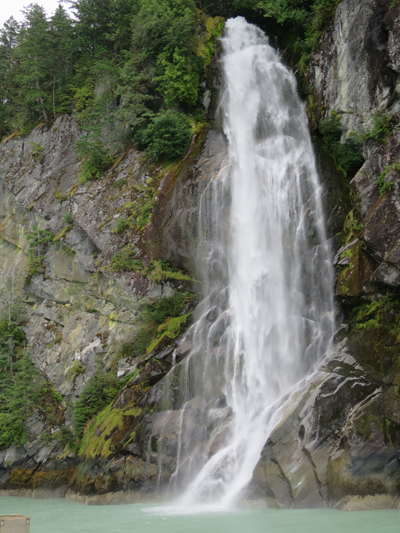 That night, we tied up in Hemming Bay to a “swifter,” the side sticks of a log raft. I was surprised we didn’t anchor, but Philippe explained that dropping the hook is too time consuming. “We never anchor,” he said. “We know the places where we can tie up.”
That night, we tied up in Hemming Bay to a “swifter,” the side sticks of a log raft. I was surprised we didn’t anchor, but Philippe explained that dropping the hook is too time consuming. “We never anchor,” he said. “We know the places where we can tie up.”
We left early the next day (homemade muffins and croissants are always available for early birds). A shout from the bridge: sea lions on port! Indeed, the brawny but sleek flipper-footed pinnipeds were lounging and lunging on an islet’s flat rocks; the early morning sun had dried their pelts to a tawny tangerine.

Our breakfast, served by Lori, our indefatigable steward, included eggs, hash browns, maple sausage, homemade bread and fresh fruit. This was a harbinger of the food to come—everyday, Janet prepared delicious dishes, with great variety. I asked her how she provisions for the 12 passengers and six crew (we all ate together). “I make up the menus in advance,” she said. “And shop accordingly. I have no set budget so I can buy the quality and variety of foods I want to prepare.”
We cruised along in the mainland’s deep fjords among resplendent mountains with tops garlanded in foggy clouds. During a quick stopover at Shoal Bay, we dropped off a cherry picker. A logging camp in Jackson Bay offered a solid introduction to BC’s timber industry. A bunkhouse that house the loggers had been constructed atop an old barge. Log rafts formed rectangles with only a few filled with logs. A jumble of pick-up and logging trucks, fuel tanks, barrels, skidders, cranes and various unidentifiable machines lined the shore.
Author Marianne Scott on beach. Photo Carol Moore-Ede
First mate Ron and engineer Madi drove one of the ship’s forklift ashore and then gingerly backed a heavy-duty truck near the ramp. The dip between land and ramp was too deep for the truck to get aboard, so the team tossed rocks into the chasm and voila, the truck’s wheels spanned the divide.
Watching the crew operate makes clear how much work and skill is required to service the working coast. It contrasts sharply with what I call the “recreational” coast, the places cruisers seek for rest and quiet contemplation. In several locations, near-shore rocks force the ship to maneuver—fortunately, it has a bow thruster besides the twin Caterpillar-driven props. Like recreational boats, Aurora Explorer plans carefully for currents and tides—in some rapids, even a ship this size could be spun around by whirlpools. The crew is vigilant about the placement of freight on its cargo deck. How much of the deck freight needs to be taken ashore to deliver that coiled spool of cable in the back? What cargo must be moved to accommodate two mighty, stacked logging trucks?
One of the impressive sights is how the two on-board forklifts perform. We know that forklifts are crucial to industry operations, but unless we’ve been involved in warehouse work, we’ve not experienced their supreme utility. Combined with the ubiquitous pallets, Ron and Madi darted across the deck and onshore, lifting or moving garbage bins, porta-potties, a rusty boiler, mattresses in plastic, shrink-wrapped cases of beer and barrels of aviation fuel for helicopters. The crews’ forklift whizzing movements resembled a ballet.
 Pierre’s at Echo Bay
Pierre’s at Echo Bay
To allow passengers to stretch their legs, Philippe landed us on a pebbly beach to spend some time exploring. Deckhand Clayton stood guard, spray can in hand in case a bear appeared. Great slabs of various rock types lined the beach—the debris glaciers carried in their bellies 10,000 years ago. They reminded us of how the relentless forces of ice have shaped the mountains and ground out fjords.
We also hiked on the 55-hectare Yorke Island, part of Canada’s Second World War history. The island, which lies at the junction of Johnstone Strait and Sunderland Channel, is windblown and thinly treed. Despite its lack of water, it was chosen as part of west coast defences. The 500 military personnel stationed here to defend against Japanese aggression, called it “little Alcatraz.” These troops included veterans of the Boer and the “Great War.”
We trekked up to the ruins of the defence post and its bunkers. The rusty supports for the six-inch MK VII guns— that never fired—and the powerful searchlights still remain. The forest, the ample rain, lichen and moss have invaded the concrete walls. I tried to imagine how the troops would have amused themselves far from big-city diversions while awaiting an attack that never came.
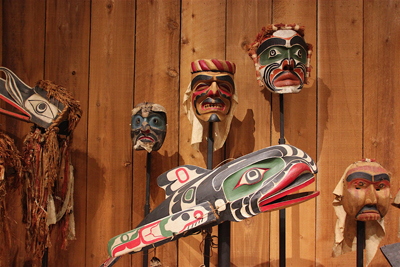 A portion of the masks at the U’Mista Cultural Centre in Alert Bay
A portion of the masks at the U’Mista Cultural Centre in Alert Bay
As the days went on, we steamed up to another fish farm needing a compressor. The mattresses found new bedrooms. The ship delivered multiple shrink-wrapped household furnishing to a new cottage. Janet continued to prepare tasty, healthy food. At the head of 125-km-long Knight Inlet with its turquoise-tinted, glacial-silt water, and bits of snow on the mountain tops, we collected two logging machines that run on tracks, like military tanks. The crew threw down tires on the wood deck to keep it from being gouged—to little avail. I sneaked down later to take a closer look at the massive equipment. One carried a formidable tree-cutting blade that replaces fellers and their chainsaws. The other, the delimber, rips branches of felled trees. With the two heavyweight machines aboard, the ship reached its Plimsoll line limit. “They wanted us to take another truck,” said Ron, “but it would’ve been too heavy, unsafe. Next time, I told them.”
An unexpected noise echoed across the water. I’d read about heli-logging, but despite our many cruises to this region, we’d never seen one in action. A hefty helicopter dove toward a clearcut area, with a grappler skimming across the logs that lay helter-skelter on the ground. The grappler seized a trunk and plopped it into the inlet. A tug thrust it into a boom. Philippe told us that heli-logging is expensive, but it avoids building erosion-prone roads and on-site logging camps.
One morning, we suddenly saw wild splashes on the water’s surface. Hundreds of white-sided dolphins swam and leaped and frolicked ahead of us. They completely ignored us but we were delighted by the show they put on.
 Billy Proctor outside his museum
Billy Proctor outside his museum
We delivered more diesel to Pierre’s at Echo Bay on Gilford Island’s, a large marina famous for its Saturday night pig roast. Just around the corner, we met 85-year-old Billy Proctor. Everyone knows Billy. He has spent his entire life in the region and has fished, logged, hunted and become a minor celebrity. He’s chronicled his adventures in The Heart of the Rain Coast—a Life Story, and built a museum. The jetsam and flotsam he’s collected over decades are neatly shelved in an oversized shed. Old tools, clocks, bottles, stone axes, even pages from the 1895 Eaton’s catalogue can be perused. It’s a great jumble of yesteryear’s collectibles on their way to becoming antiques.
Before returning to our starting point, we stopped by Alert Bay, an Indigenous village on Cormorant Island. We had ample time to visit the Namgis Burial Ground with its carved memorial poles, or to enjoy the U’mista Cultural Centre, with its spectacular collection of potlatch ceremonial objects. I visited the harbour master, Stephen Bruce, whom I’d met before, and was introduced to master carver Bruce Alfred, who had a yellow cedar, bentwood cradle rattle on his lap—the pebbles inside create the sound. “It’s been commissioned,” he said. “I’ve drawn the bear, salmon, whale and orca designs and soon I’ll carve and paint the rattle with our traditional red, black and green colours.”
The voyage aboard Aurora Explorer was a treat for us and the other passengers. We hadn’t experienced the working coast—those industries that keep BC’s coffers full. We viewed seals, eagles, sea lions and dolphins. Although no bears turned stones on beaches, we saw a bear with its perky ears swimming across a channel. The crew was highly competent, and cheerfully answered our many questions. If you lack a boat or can never bring your yacht here, cruising on this landing craft is a perfect method of experiencing the wild and working coast of British Columbia.

